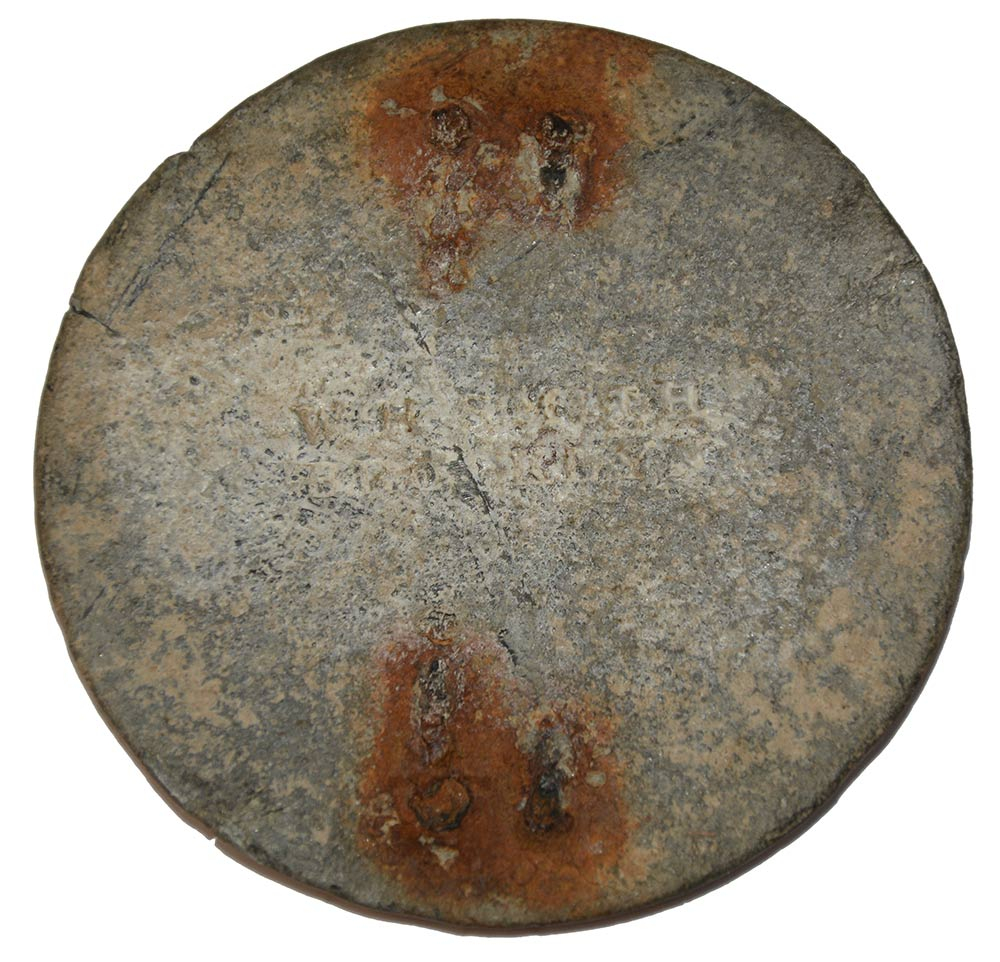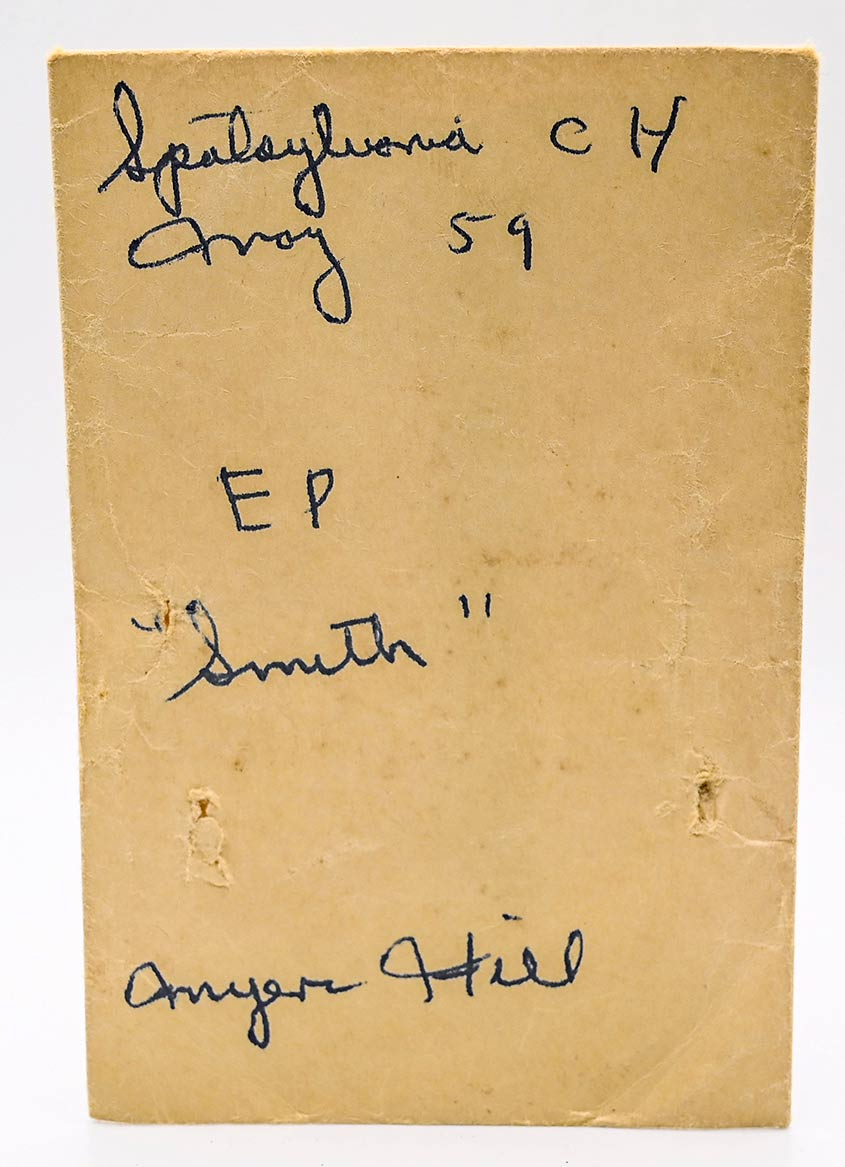site search
online catalog
SMITH MARKED ROUND EAGLE CARTRIDGE BOX SHOULDER BELT PLATE FROM MYERS HILL, SPOTSYLVANIA, EX-KERKSIS

Hover to zoom



$450.00
Quantity Available: 1
Item Code: 490-5858
Shipping: Determined by Method & Location of buyer
To Order:
Call 717-334-0347,
Fax 717-334-5016, or E-mail
This regulation belt plate for the cartridge box sling came from the collection of Syd Kerksis, well-known and respected early collector and author, and still has his annotated envelope indicating he found it in May 1959 at Spotsylvania Court House, specifically at Myer’s Hill. This was a commanding position giving a view of Confederate lines that became important on May 14 as Grant shifted his forces to his left, bringing the 5th and 6th Corps over from his right to extend his left south on the eastern side of Confederate lines. Foul weather slowed the movement of troops and though Union infantry pushed Confederate cavalry away from the location, they returned with two brigades of infantry from Mahone’s brigade, artillery and fellow cavalry of Chambliss’s brigade to drive back elements of Upton’s 6th Corps, almost capturing Meade in the process. Union forces took the position again later in the day, but Grant continued his move southeast toward the North Anna and, eventually, Cold Harbor.
The face shows as a mix of brown and olive with thin gray-white and brown stains. The rim has just a couple of tiny dings and the detail is good, but near the eagle’s beak and claw the iron wire inside the back forming the loops corroded and the rust has pushed through the rolled brass, forming a thick, dark brown spot near the beak and gray, green and brown spot near the claw. The reverse has an even lead-solder fill, mixed gray and white in color with rust stains at the bases of the iron wire loops. There is s short crack extending inward at one edge. The center preserves a light, but legible “W. H. SMITH / BROOKLYN“ stamp. He worked at No. 44 State St. in South Brooklyn and advertised “brass trimmings for all kinds of military equipments… warranted to stand US inspection.” He appears to have had large U.S. contracts both before and during the war, at least into Summer 1864, and also produced SNY plates for New York (see Bazelon’s additional note in the combined Volume 1 entry of his Directory.)
These plates were adopted in 1826 with hooks on the reverse for the bayonet shoulder belt and made of brass for artillery and white metal for infantry. This was changed to brass for both services in 1831 and when the bayonet was moved to the waist belt around 1842, the plates were redesigned with two loops on the back for wear as fixed ornaments on the cartridge box sling and plates with hooks were relegated to the NCO and musician’s sword shoulder belts. (Some militia versions used hooks at a different angle for wear on the waist belt.) Although in theory the plate was dropped with introduction of the 1864 cartridge box rigs with no plates, the plate remained in use in the field and was not discontinued until the new 1872 sets of accouterments were distributed.
This has an interesting find location, marking to known maker, and provenance to a respected early collector and author. [sr] [ph:L]
~~~~~~~~~~~~~~~~~~~~~~~~~~~~~~~~~~~
THIS ITEM, AS WITH ALL OTHER ITEMS AVAILABLE ON OUR WEB SITE,
MAY BE PURCHASED THROUGH OUR LAYAWAY PROGRAM.
CLICK HERE FOR OUR POLICIES AND TERMS.
THANK YOU!
Inquire About SMITH MARKED ROUND EAGLE CARTRIDGE BOX SHOULDER BELT PLATE FROM MYERS HILL, SPOTSYLVANIA, EX-KERKSIS
Most Popular
Historical Firearms Stolen From The National Civil War Museum In Harrisburg, Pa »
Theft From Gravesite Of Gen. John Reynolds »
Selection Of Unframed Prints By Don Troiani »
Fine Condition Brass Infantry Bugle Insignia »
Large English Bowie Knife With Sheath 1870’S – 1880’S »
Imported (Clauberg) Us Model 1860 Light Cavalry Officer's Saber »
featured item
VERY RARE 1834 ENGINEER AND MEDICAL STAFF SWORD BY HENRY BOKER, BELONGING TO BREVET BRIGADIER GENERAL JOHN HENDRICKSON, WHO LOST A LEG AT FREDERICKSBURG, 83rd NEW YORK VOLS (9th NYSM) AND 13th V.R.C.
New patterns of swords for the U.S. army were developed from 1832 to 1834. This elegant smallsword pattern (variously called by collectors the 1832 or 1834 pattern) was designated for officers of Engineers and Medical Staff (and Pay Department as… (870-325). Learn More »


